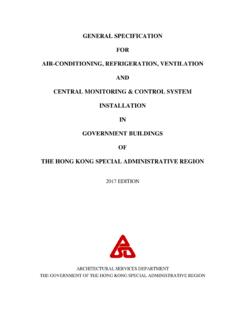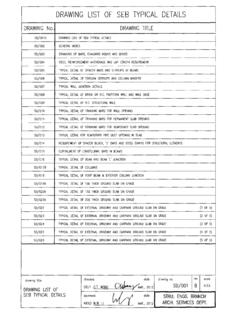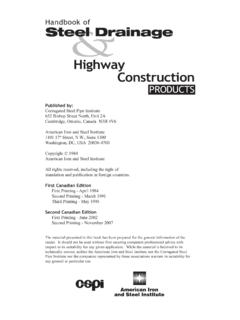Transcription of General Specification for Building 2012 Edition – 1 …
1 General Specification for Building 2012 Edition 1st Corrigendum. The General Specification for Building 2012 Edition (GS 2012 ) is reviewed periodically to facilitate updating of the Specification in a continuous process. Corrigendum No. GS 2012 - 01 is issued on 1 August 2014 to incorporate amendments to the 2012 Edition which are highlighted in the following pages. After an introductory period of 3 months, GS 2012 with Corrigendum No. GS2012-01 shall apply to all tenders to be invited by ArchSD on or after 1 November 2014. 1 / 20 ARCHITECTURAL SERVICES DEPARTMENT General Specification FOR Building 2012 Edition Corrigendum No. GS 2012 01 (Effective from 1 November 2014) The following clauses and indexes are amended in the above Edition of General Specification for Building . Amendments to Section 1 Regulations "Regulations" mean any Ordinance or Regulation published by Government of Hong Kong, byelaws of any local or duly constituted authority and rules or regulations of public bodies and companies which may be applicable to the Works.
2 Trees and shrubs Provide a record of existing trees, if any, within and in close vicinity (within 2000 mm) of the site boundary and works areas. (A plant is considered as a tree if its trunk diameter measures 95 mm or more at a height of 1300 mm above the ground level. (Guidance on measurement of tree diameter is given in Agriculture, Fisheries and Conservation Department s Nature Conservation Practice Note )) Photographic record and location plan for individual tree together with the Tree Schedule shall be submitted within 28 days after commencement of the Works or nomination by the SO. The Tree Schedule shall show the following particulars: (a) A number identity for each tree, also marked on each photograph; (b) The species (scientific names and Chinese common names); (c) Trunk diameter (at 1300mm above the ground level); (d) Tree crown spread; (e) Overall height; (f) Condition of the tree; (g) Existing ground level at the root collar. Protect and preserve all existing trees and shrubs on Site.
3 No physical disturbance including transplanting/felling/pruning of any existing tree shall be permitted without prior written consent of the SO and the statutory approval. Take precaution and provide all necessary on-site protection works/measures (including tree surgery works if so required) for individual existing tree, if any, within or in close vicinity (within 2000 mm) of the site boundary and/or works area throughout the Contract period. Temporary fencing, if necessary shall be provided to prevent the encroachment of equipment or materials and contamination of the surrounding ground by oil or other deleterious substances. Do not bank spoil, vegetable soil or other materials within the drip-line zone of individual trees. If it is necessary to trim or cut back trees and shrubs, it must be done under the direction and supervision of the SO in strict compliance with Clauses to and Section 25 of the Make allowance in method of operation and vehicular access for tree preservation during the period of Works.
4 Amendments to Section 3 Definitions (i) (a) "Top soil" is soil capable of supporting vegetative growth. (b) "Inert construction and demolition material" shall mean rock, rubble, earth, soil, concrete, asphalt, brick, title and masonry generated from construction and demolition works. 2 / 20 (ii) "Suitable material" shall be approved and to consist of naturally occurring or processed material, or inert construction and demolition material, which at the time of deposition is capable of being compacted in accordance with the specified requirements to form stable areas of fill. The soluble sulphate content of the material placed within 500 mm of concrete, cement bound material or cementitious material shall not exceed grams of sulphate, expressed as SO3, per litre. The total sulphate content, expressed as SO3, of the material placed within 500 mm of metal work shall not exceed by mass. The method of testing of the total sulphate content shall be in accordance with Geospec 3 - Model Specification for Soil Testing issued by the Geotechnical Engineering Office.
5 (iii) "Unsuitable material" is material other than suitable material or containing the following: (a) Material susceptible to volume change, including marine mud, soil with a liquid limit exceeding 65% or a plasticity index exceeding 35%, swelling clays and collapsible soils, (b) Peat, vegetation, timber, organic, soluble or perishable material, (c) Dangerous or toxic material or material susceptible to combustion, or (d) Metal, rubber, plastic or synthetic material. (iv) "Rock" is hard material which in the opinion of the SO can only be removed by the use of blasting, wedges or pneumatic drills and shall include individual boulders or other masses exceeding m3 in size. (v) (a) "Rock fill" shall consist of pieces of concrete or hard, durable rock of which, in the opinion of the SO, not more than 30% by mass is discoloured or shows other evidence of decomposition. Masonry, brick and similar materials shall not be used instead of rock unless permitted by the SO.
6 No individual particle shall exceed m3 in size or the thickness of the filling whichever is the least, suitably graded for deposition and compaction in accordance with Clause (b) "Recycled rock fill material" (Grade 200) shall be recycled rock or inert construction and demolition material which is hard and durable, and free from cracks, veins, and other evidence of decomposition. (vi) "Hardcore" shall comprise the following material to pass rings varying from 28 to 150 mm (from 28 to 200 mm for recycled rock fill), or else, single sized hardcore may be used: (a) Rock fill. (b) Broken stone, hard brick, concrete or other comparable hard, inert, approved material. The material shall be free from dust, rubbish or deleterious foreign matter. (vii) " General filling material" shall be "suitable material". It may contain up to 25% rock distributed evenly throughout the whole mass of the material. General filling material shall contain no material exceeding 200 mm in size.
7 3 / 20 (viii) "Special filling material" shall be " General filling material" capable of passing through a 75 mm BS sieve. The material shall be sampled and tested according to Geospec 3. The material shall have the following characteristics: (a) Liquid limit shall not exceed 45%. (b) Plasticity index shall not exceed 20%. (c) Coefficient of uniformity shall be greater than 50. (d) The percentage passing a 63 m BS sieve shall be less than 45% by weight. (ix) "Embankment", "filling area" or "area of fill" means an area on the Site other than a foreshore or sea-bed where the ground level shall be raised by filling in layers as part of the Works. (x) "Trench excavation" means excavating from ground level not exceeding 5000 mm in width at surface. (xi) "Bulk excavation" means excavation in the open other than trench excavation. (xii) Well-graded material shall consist of material that has a coefficient of uniformity exceeding 10.
8 (xiii) Uniform-graded material shall consist of material that has a coefficient of uniformity of 10 or less. Note: The definitions of trench excavation and bulk excavation stated in sub-clauses (x) and (xi) are for the purposes of the GS only and do not apply to the measurement of excavation in Bills of Quantities which are measured in accordance with the current Edition of the Standard Method of Measurement of Building Works for use in Hong Kong. Temporary works for earthworks Design the Temporary Works associated with earthworks, including temporary slopes, stockpiles and drainage, such that the risk of failure is not more than that which would be adopted if the Temporary Works were to be permanent. Allowance may be made in the design of the Temporary Works for the shorter design life and for the risk to persons and property and the surface water and groundwater conditions which may occur during construction.
9 Earthwork (i) Carry out excavation and earthwork in such a manner as to prevent erosion or slips. Limit working faces to safe slopes and height. Do not stockpile material where it might cause a landslide or failure of excavation face. (ii) Provide and maintain necessary temporary access roads and temporary drainage, and divert and subsequently reinstate permanent drainage systems. Submit proposed alignments and levels of temporary access roads for approval prior to their construction. Provide temporary roads with sufficient drainage ditches over their full length. (iii) Monitor weather forecasts to ensure awareness of impending heavy rain and inspect the site frequently during periods of sustained rainfall. (iv) Seal, cover with impermeable sheeting or protect by other methods approved by the SO, all excavation and earthwork at the cessation of the days work and 4 / 20 when heavy rain is expected. (v) Material handling and storage areas shall be levelled and well drained.
10 Stockpiles of material shall be sprayed with water or a dust suppression chemical to minimize dust generation. (vi) Carry out excavation and earthwork in the dry unless otherwise authorised by the SO. Carry out the formation of cuttings and filling in such a manner that the surfaces have at all times a sufficient minimum crossfall and, where practicable, a sufficient longitudinal gradient to enable them to shed water and prevent ponding. Adopt a method of working which exposes the minimum area of bare soil across the site. Follow up earthwork immediately with either approved temporary protection or the permanent surface protection and drainage work. (vii) Rapidly disperse water, whether shed on to the excavation and earthwork, or arising from any other source including flowing into the Site from elsewhere. Provide temporary water courses, ditches, catchpits, drains, pumping or other means of maintaining excavation and earthwork free from water.











